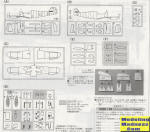
| KIT #: | 09273 (Jt 173) |
| PRICE: | 2400 yen |
| DECALS: | Two options |
| REVIEWER: | Scott Van Aken |
| NOTES: | 1998 limited release. Includes resin parts |

| HISTORY |
From the Bf-109F-4 onward, the new 20 mm Mauser MG 151/20 with 200 rounds was used as the Motorkanone. The first F-4s reached frontline units in June 1941. Production lasted exactly a year between May 1941 and May 1942, with 1,841 of all F-4 variants produced. Some of the later models were capable of mounting two 20 mm MG 151/20 cannons under the wing in faired gondolas with 135 rpg. These were designated F-4/R1 and 240 of them were produced by WNF in the first quarter of 1942. This optional additional armament was standardized as field kit for later G and K series. A special high-altitude variant, the F-4/Z featuring GM-1 boost, was also built with a production run of 544 in the first quarter of 1942 and saw extensive use. Finally, the Erla factory produced 576 tropicalized F-4 trop in the first half of 1942.
With its initial engine rating of 1,200 PS, the maximum speed of the F-4 (and F-3) was 635 km/h (394 mph) at rated altitude; and with the clearance of the full rating of 1,350 PS, maximum speed increased to 659 km/h (410 mph) at 6,200 m (20,341 ft).
| THE KIT |
 This
kit is the fighter bomber version of the 109F-4. As Hasegawa did not produce the
specialized bomb rack or a bomb for this variant on one of their sprues, those
items are provided in resin.
This
kit is the fighter bomber version of the 109F-4. As Hasegawa did not produce the
specialized bomb rack or a bomb for this variant on one of their sprues, those
items are provided in resin.
If you have ever built any of Hasegawa's 1/48 'round wing' 109s, you will find nothing different in this boxing aside from the aforementioned resin parts. Cockpit is fairly nicely done, though more modern kits have more detail. Holes need to be opened up in the lower wing to accept the bomb rack. The kit does not provide an instrument panel decal as is the norm for many later Hasegawa kits. I like that the cockpit tub can be installed after the fuselage halves are together.
You are provided two different prop blade options
depending on which markings option you will be using. The exhaust fit from the
outside making painting of these items much easier than on some newer kits.
Landing gear is acceptable and while the kit does not have separate flight
control surfaces, it does have separate flaps, slats and radiator exhaust flaps.
It also has a three piece cockpit transparency set so you can pose the canopy
open if you wish.

Markings are for two planes. One is the box art plane from JG2 in standard RLM 74/75/76 with a white rudder and fairly heavy fuselage mottling. The other is from JG 26 with a yellow rudder and lower cowling. It also has fairly heavy fuselage mottling. Decals are nicely printed, but old school in that the whites are off-white. They should be fairly viable and one should use hot or very warm water with them.
| CONCLUSIONS |
This kit has been superseded in terms of detail by those from Eduard. However, the Eduard kit can be quite frustrating to build; not an issue with the Hasegawa offering. Well worth getting if you like 109s.
| REFERENCES |
https://en.wikipedia.org/wiki/Messerschmitt_Bf_109_variants#F-3,_F-4,_F-5,_F-6
December 2006
Copyright ModelingMadness.com. All rights reserved. No reproduction in part or in whole without express permission from the editor.
If you would like your product reviewed fairly and fairly quickly, please contact the editor or see other details in the Note to Contributors.